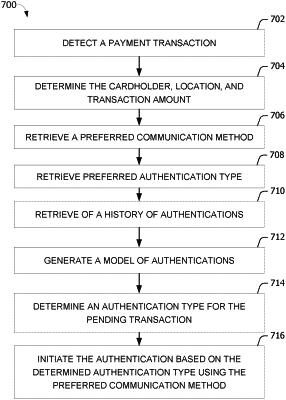| CPC G06Q 20/40145 (2013.01) [G06N 20/00 (2019.01); G06Q 20/3823 (2013.01); G06Q 20/4097 (2013.01)] | 17 Claims |

|
8. A computer-implemented method for improved fraud prevention and payment transaction authentication services, the method implemented using an adaptive authentication (AA) computer device including at least one processor for executing instructions and in communication with a payment processing network, and at least one memory device for storing data including the executable instructions, the AA computer device in communication with the memory device, said computer-implemented method comprising:
storing user preferences for each of a plurality of cardholders;
retrieving, from a database, (i) historical transaction data for a plurality of historical transactions processed over the payment processing network by the plurality of cardholders, and (ii) a respective one of a plurality of cardholder authentication types used for each of the historical transactions;
building, based on the historical transaction data, a plurality of example data sets, each of the example data sets including, for a respective particular merchant and a respective particular cardholder, i) a preferred one of the plurality of cardholder authentication types used by the particular cardholder for transactions with the particular merchant and ii) a combination of transaction parameters including a frequency of transactions by the particular cardholder with the particular merchant, a range of transaction amounts for transactions by the particular cardholder with the particular merchant, and a geographic location of the particular merchant;
generating, using the at least one processor, a model from the plurality of example data sets built based on the historical transaction data;
receiving pending transaction data for each of a plurality of pending transactions from the payment processing network, the pending transaction data for each of the plurality of pending transactions including a cardholder identifier of a respective cardholder of the plurality of cardholders, a pending transaction merchant identifier associated with a particular merchant for each transaction, and a pending transaction amount;
for each of the plurality of pending transactions, apply a machine learning program to the generated model to dynamically predict a preferred cardholder authentication type for a current cardholder associated with each transaction by:
inputting, into the machine learning program, particular example data sets from the plurality of example data sets that correspond to historical transactions performed at the particular merchant by cardholders that are similar to the current cardholder;
training the machine learning program by analyzing, using deep learning algorithms of the machine learning program, the inputted particular example data sets to recognize at least one pattern in the historical transactions performed at the particular merchant by the similar cardholders;
inputting the pending transaction data for each of the plurality of pending transactions into the trained machine learning program as a novel input; and
dynamically predicting, using the trained machine learning program, the preferred cardholder authentication type based on i) the novel input including the pending transaction data and ii) the at least one pattern recognized using the deep learning algorithms; and
transmitting to a cardholder computing device the respective current cardholder associated with the transaction for each of the plurality of pending transactions an authentication request of the corresponding dynamically predicted preferred cardholder authentication type.
|